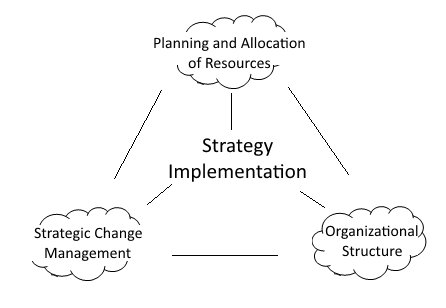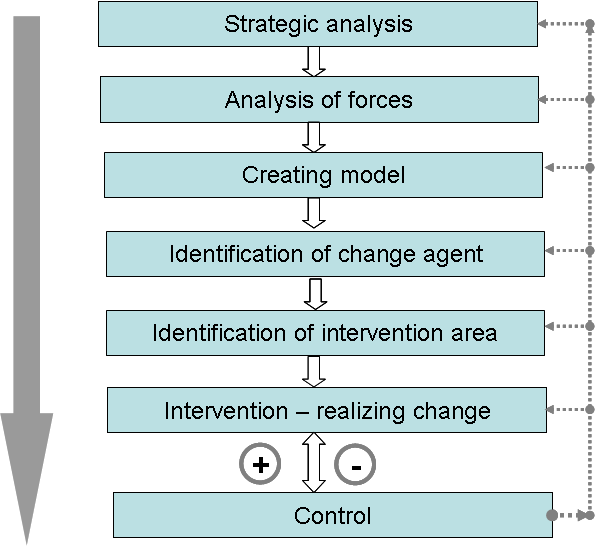7.2. Resources, Organizational Structure, Change Management
Apart from developing short-term plans, strategy implementation requires addressing other aspects as well:
-
Communication Strategy
-
Securing Resources (the company’s ability to secure resources should be assessed as a part of the strategy)
-
Potential changes in the organizational structure which may require strategic changes and
- Systematic Change Management – necessary to implement when setting new strategies

Strategy Communication
A crucial aspect to keep in mind when implementing a new or revised strategy is how the company will communicate the strategy (how the strategy will be communicated outward and inward, to the company). These aspects are extremely pertinent to SMEs, as informal practices and plans often only exist as internalized ideas of the company’s owners and founders. Open, systematic and official communication strategies can thus exponentially contribute towards strengthening the company’s competitive position:
-
Clarity and transparency, brought on by a concise communication strategy to the company’s external partners (customers, suppliers, the public and other partners), as well as internally (i.e. to employees) can significantly reinforce the company’s credibility, positive company perception etc.
-
A well-formulated strategy (incl. for example the company’s mission and values) can significantly differentiate the company from its competitors.
-
A high-quality, direct and succinct communication strategy can have a positive effect on people management – building a sense of belonging amongst the company’s employees, reducing uncertainty within the company, and contributing to improving corporate climate and culture etc.
 When setting a new strategy or drastically changing the current strategy, it is advisable to determine to whom (outwards and inwards) and how the contents of the strategy will be communicated. The following aspects should be taken into consideration:
When setting a new strategy or drastically changing the current strategy, it is advisable to determine to whom (outwards and inwards) and how the contents of the strategy will be communicated. The following aspects should be taken into consideration:
-
What (whether the whole strategy or just the general outline and parts of the strategy pertinent to the given employees ) will be available in the company and to whom (perhaps more solutions will be possible, from communicating the entire strategy in detail to everyone – suitable i.e. for family companies that comprise primarily family members and are not concerned with the leakage of sensitive information – to carefully selecting relevant parts of the strategy for various job positions, departments and levels of management in order to prevent the leakage of sensitive information).
-
How the strategy will be communicated in order to ensure that it is communicated in a concise and unified manner (without the risk of losing information, misinterpretation etc.), the employee’s and external partners’ understanding and acceptance of the strategy etc. Once again, there is a wide range of possible solutions, most of which can be applied in combination with one another (website or intranet, company-wide workshops, team building activities, events for key partners, other company activities etc.), and implementing communication permanently, consistently and openly (not just rigid one-way communication, but also allowing for open discussions etc.).
-
Who will be responsible for communicating the strategy
Organizational Structure
After successfully implementing a strategy, it is also imperative that it remains in line with
other organization-related aspects of the company, especially: corporate culture, the organizational remuneration system and HR management in compliance with internal organizational standards and regulations as well as the company’s organizational structure (Tilles, 1963, de Witt a Meyer, 1994).
Since most SMEs have an organizational structure that evolves on its own over time, it may not be adequate when it comes to implementing a new strategy. An inadequate structure may reduce the company’s ability to adapt to external changes, can result in rigidity, limit flexibility and suppress creativity and initiative. In order to successfully implement a strategy, it is then necessary to consider whether or not the company’s current organizational structure would support such a strategy. It is advisable to take into consideration the content and function of the organizational structure in terms of seniority, subordination, collaboration or arrangement of controls and information sharing.
Strategy and Compliance with Corporate Culture
Changes in structure, the internal environment and corporate culture are all inextricably linked. When making changes in the organizational structure, in terms of the entire strategic management process as well as strategy implementation, other factors play an important role, such as organizational culture and the values that other co-workers adhere to. Building corporate culture also results in the formation of relationships both within and outside of the organization, which are crucial in terms of strategy implementation – in other words, “People rarely succeed at what they do not enjoy.” (Peters, Waterman, 1993) Organizational culture should then be a stabilizing force, maintaining a sense of continuity in the organization’s dealings, and should also serve as a competitive advantage in support of implementing the company’s strategy. Problems arise in the event that the organizational culture does not support the selected strategy.
Resource Planning and Allocation
Strategy implementation does not only entail changes in the organizational structure, but also involves the equally crucial management and allocation of resources. In order for strategy implementation to be successful, it is necessary to ensure the availability of basic resources in the required quality, quantity and time frame – primarily staff, finances, expertise and information, i.e. social capital (contacts, connections) etc. Insufficient capacities are the primary issue which prevents most SMEs from successfully realizing their plans.
Managing Strategic Change
An essential aspect of strategy implementation is also managing to implement changes which may arise from the newly formed or revised strategy. Significant changes with a high impact on the company’s current operations and higher probability of resistance or overall complexity should be systematically managed. Various approaches suggest carrying out a combination of some of the steps described below (Drdla and Rais, 2001, Senior 2002):
-
Strategic Analysis – which should, amongst other things, lead to the decision of whether or not/which changes should be implemented as a part of the strategy.
-
Analysis of Forces – prior to implementing the aforementioned changes, it is necessary to identify the factors which will reinforce these changes in terms of implementation organization, as well as factors which will work against these changes (what can have a high impact on the success rate of changes is e.g. certain aspects of corporate culture etc.).
-
Analysis of Desired Results of Change – The next step should involve formulating detailed definitions of the desired target state which the implemented change should bring about (this can be achieved by setting quantified targets, which allow for unambiguous assessment).
-
Subsequently, Change Agents should be identified – i.e. employees who will be responsible for promoting changes within the organization (this means e.g. positive communication and showing support for the changes as well as addressing and overcoming negativity towards the changes from other employees).
-
Identification of Systems Affected by Change – Since individual parts, systems and processes in the company are closely interconnected, it is advisable to determine which of them will be affected by change and how to manage these changes. These include human resources, organizational structure, technology, organizational processes and information channels.
-
Intervention – this entails the actual implementation of change. This stage should be thoroughly planned out in terms of the schedule and its contents. Special attention should be paid to unfreezing the current situation, realizing change and subsequent reinforcement of the new situation after the change has been implemented. It is best to select the general logic (or strategy) for enforcing the change – for example, participation, persuasion, coercion, training, communication etc.
-
Assessment – Systematic assessment should be carried out during the change implementation process in order to evaluate the progress of change implementation.

Management of Strategic Changes in the Company (adapted from Drdla and Rais, 2001)


